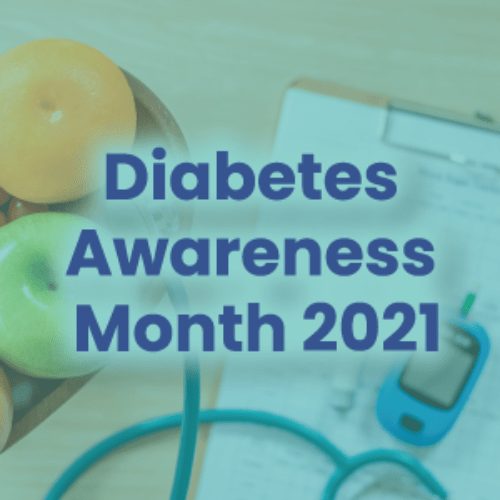
Designated for diabetes awareness since 1975, November has been officially recognized as National Diabetes Month since the early 1980s. In October 1981, President Ronald Reagan declared November National Diabetes Month, with the American Diabetes Association (ADA) launching a public education campaign following his announcement. The nonprofit trademarked “American Diabetes Month” in 1997.
In 1991, November 14 was designated World Diabetes Day to mark the birthday of Dr. Frederick Banting, who co-discovered insulin with John James Rickard Macleod. The International Diabetes Federation and the World Health Organization launched the campaign in response to the rapid rise of diabetes across the globe.
Thirty years later, more than 10% of the population of the United States has diabetes. In 2018, there were 34.2 million Americans living with diabetes, according to the ADA.
What is diabetes?
There is sometimes confusion about the difference between type 1 and type 2 diabetes, but there is also a third type of diabetes that some pregnant women get called gestational diabetes. Not only that, but there is also a condition called prediabetes that many people aren’t aware they have, as well as a rarer group of inherited forms of diabetes called MODY. Let’s look at the different types of diabetes.
Prediabetes
According to the Centers for Disease and Control (CDC), prediabetes is a serious health condition in which blood sugar levels are higher than normal, but not high enough to be diagnosed as type 2 diabetes. More than one in three Americans, approximately 88 million adults, have prediabetes. But 84% don’t know they have it.
If you have prediabetes, that means the cells in your body don’t respond normally to insulin, a hormone made by the pancreas that allows your body to use glucose (sugar) from food as energy. The pancreas keeps making more insulin to try to get the cells to respond, but eventually it can’t keep up and your blood sugar levels rise.
There are no clear symptoms of prediabetes, which is why it often does undetected until it causes serious health problems like type 2 diabetes. If you have certain risk factors for prediabetes, be sure to talk to your doctor. Risk factors include:
- Being overweight
- Being 45 years or older
- Having a parent, brother, or sister who has type 2 diabetes
- Being physically active less than three times a week
- Having gestational diabetes or having a baby who weighed more than 9 pounds at birth
- Having polycystic ovary syndrome (PCOS), which can cause insulin resistance
African Americans, American Indians, some Asian Americans, Hispanic or Latino Americans, and Pacific Islanders are at a higher risk for developing prediabetes.
If you have prediabetes, certain lifestyle changes can help you reverse it. These include:
- Getting at least 150 minutes of physical activity per week.
- Keeping your weight in a healthy range.
- Drinking more water and fewer sugary drinks.
- Not smoking.
- Eating healthy foods.
Type 1 diabetes
With type 1 diabetes, the body doesn’t produce insulin, or it produces very little insulin. Although it can develop at any age, type 1 diabetes is usually diagnosed in children, teenagers, and young adults, and was previously known as insulin-dependent or juvenile diabetes. About 5 to 10% of people with diabetes have type 1 diabetes, and it is currently unknown how to prevent it. However, similar to prediabetes, lifestyle changes can help manage type 1 diabetes.
With type 1 diabetes, it’s important to check blood sugar regularly. Your doctor can tell you how often you should check it and what your levels should be. It’s important to keep your levels as close to that target as possible. You’ll also need to take insulin shots every day to manage your blood sugar levels and get the energy your body needs.
Type 2 diabetes
Type 2 diabetes is the most common type of diabetes. About 90 to 95% of Americans with diabetes have type 2 diabetes. Instead of not producing insulin, with type 2 diabetes, your body doesn’t use it properly. It usually develops in people over the age of 45, but younger people can develop it as well.
Some people with type 2 diabetes are able to control their blood sugar levels with a healthy diet and exercise, but other people may need insulin or medication to manage it. Regular blood sugar checks and healthcare appointments are also necessary for managing type 2 diabetes. It is also important to recognize the signs of low or high blood sugar and what to do about them.
Gestational diabetes
Gestational diabetes is a type of diabetes that can develop in pregnant women who don’t already have diabetes. Between 2 and 10% of pregnancies in the United States are affected by gestational diabetes, according to the CDC. Gestational diabetes happens when the body can’t make enough insulin during pregnancy. Although all pregnant women have some insulin resistance during late pregnancy, some women may have insulin resistance before they get pregnant (for example, if they have PCOS). This can put them at a higher risk of developing gestational diabetes. About half of women with gestational diabetes go on to develop type 2 diabetes, so it’s important to talk to your doctor about how to lower your risk.
MODY
Maturity-onset diabetes of the young (MODY) is a group of different types of inherited forms of diabetes that usually develop in adolescence or early adulthood. It was given this name because it acted more like type 2 diabetes even though it was found in young people. MODY limits the body’s ability to produce insulin, but it’s not quite the same as type 1 diabetes. It is a monogenic disease, meaning it is caused by a single gene mutation. If you have a family member with MODY, you have an increased risk for getting it. MODY accounts for about 5% of diabetes cases in the United States.
Although diabetes is a chronic health condition, you can still live a full life no matter what type you have. Staying on top of your blood sugar levels, taking your insulin or medication as needed, and keeping in frequent touch with your doctor and health care team are important parts of managing diabetes, but lifestyle changes can help too. If you need help learning ways to manage your diabetes, you can visit the ADA or CDC websites for resources.

